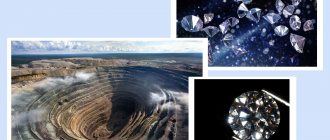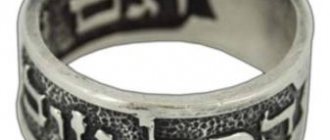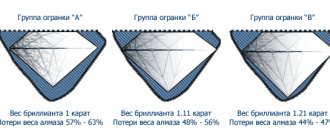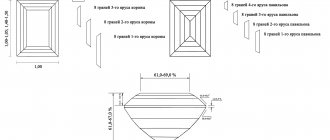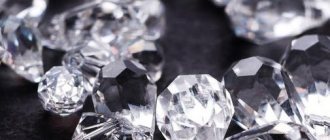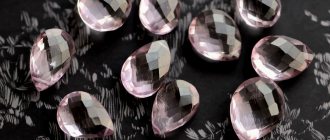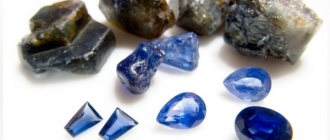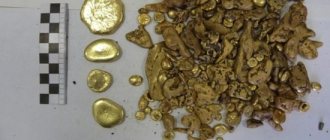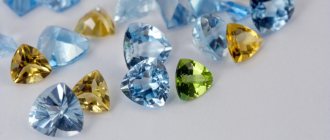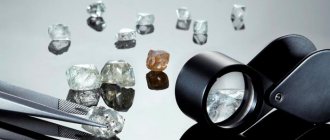A girl's best friend, gemstones, are judged not only by carat weight, clarity and color, but also by cut. It determines how beautiful its shape and the play of light in it will be. What are the main types of cuts? Let's get acquainted with the basics of jewelry.
The cut of a stone and its shape are not the same thing. Shape refers to the overall outline of the processed diamond and looks like some kind of geometric figure: circle, square, rhombus, triangle, oval, etc. The cut characterizes the number, location, shape and proportions of the stone's facets. Stones of the same shape may well have different cuts
Round cut
Number of faces: 57, 33, 17
What decorations is it used for? For anyone – this is a universal type of diamond cut
The round cut is a time-tested classic of diamond cutting. She is the oldest among the “sisters” and “brothers” - other types of cutting of precious stones. It was invented in the early 1900s. Then diamond saws were invented, which allowed jewelers to work with the hardest mineral of the Earth and the Universe, that is, using some diamonds to turn others into diamonds.
The 57-facet round cut best showcases the brilliance and play of light in the diamond and contributes to its longevity, minimizing the risk of chips and other external damage. This cut is highly valued when resale of the stone. For small diamonds, a simplified round cut of 33 facets (for stones weighing up to 0.99 carats) and 17 facets (0.29 carats or less) is used.
A feature of the round cut is the large loss of weight of the nugget: after processing, up to 50% of the initial weight of the diamond “goes away”.
SL gold ring with diamonds (price on link)
Which zodiac sign is the marcasite stone suitable as a talisman?
When choosing a mineral, it is important to consider your horoscope. The crystal received its extraordinary power thanks to Mars and Neptune - these planets are considered the patrons of the gem. Magicians and esotericists are confident that the mineral is capable of changing human destiny.
- Astrologers believe that Aries and Scorpios should wear jewelry with a gem. The crystal improves the emotional state of representatives of these zodiac signs.
- Marcasite is also ideal for Sagittarius and Capricorn. It brings good luck in any endeavor, gives peace of mind and improves health. In addition, the gem helps to achieve well-being in the family.
- Marcasite is an excellent choice for representatives of the air element. This includes Libra, Gemini and Aquarius. For these people, the crystal helps improve their health and gives them creative energy.
Marcasite is not suitable for all representatives of air signs - sometimes there is incompatibility at the energy level. To determine it, you need to hold the stone in your hands.
Jewelry with this stone can be worn by Aries, Scorpio, Sagittarius, and Capricorn.
The crystal is not suitable for Cancers and Pisces. For representatives of these signs, the stone can bring only misfortunes and problems. The gem is neutral towards other people. However, for some people it helps in matters that are most significant.
Marcasite is a unique gem that can significantly improve the life and health of its owner. To achieve good results, it is important to choose the right gem and follow the recommendations for its use.
Oval cut
Number of faces: 57
What decorations is it used for? Rings, earrings, bracelets, necklaces, pendants
A round cut variant that came into use in jewelry in the 1960s. “Oval” has wedge faces of a larger area and an elongated shape, giving the stone a beautiful shine and shimmering shades in the light. When placed in a ring, a stone of this cut visually lengthens the fingers, making them thinner and more graceful.
Gold pendant SL with diamonds and sapphires (price on the link)
The history of the origin of marcasite stone and its deposits
Until 1814, this term was used to describe 2 minerals. These included pyrite and marcasite itself. However, a scientist from Australia, Wilhelm Heidinger, described the differences between these crystals.
Marcasite is also called radiant pyrite. This is due to the brass tint of the mineral. The crystal is also often called drop silver. However, in reality it has nothing to do with this metal.
In ancient times, people used marcasite to make fire.
The mineral was often used to make weapons. In Europe, crystal was often used as an alternative to diamonds.
Marquise cut
Number of faces: 55
What decorations is it used for? Rings, earrings, pendants
The French word marquise is pronounced mar-ki-ee-iz. Therefore, the type of cut, named after the Marquise de Pompadour, the favorite of Louis XV, in Russian sounds and is written as... a male, not a female, aristocratic title. The oval cut with pointed oblong ends immortalized the flirtatious smile of the legendary beauty. However, for many, this type of processing of precious stones is more reminiscent of a boat in shape.
A ring with a marquise cut nugget visually lengthens the fingers of the wearer. Be careful with the decoration: the sharp wedge-shaped ends are a vulnerable part of the stone cut “to resemble an aristocrat” because it is fragile.
Gold earrings SL with diamonds and amethysts (price on the link)
Cut "Pear" ("Drop")
Number of faces: 55–56
What decorations is it used for? Earrings, pendants, necklaces
This type of gemstone processing combines the features of the oval cut and the marquise cut. The pear-shaped end has only one tapered end, and it is this end that must be especially carefully protected by the frame. Drop stones, like ovals and marquises, create the illusion of a longer, more graceful neck or fingers when it comes to a ring.
Gold pendant SL with diamonds and sapphires (price on the link)
Princess cut
Number of faces: 49, 65, 68, other numbers possible
What decorations is it used for? Rings, earrings, pendants
Like the round cut, the “Princess” cut is famous for the generous play of light in the stone, but at the same time it has a rectangular (less often square) shape. Invented in the late 1960s - early 1970s. A nugget with this cut loses less of its original weight and, as a rule, costs less than a classic round cut diamond with 57 facets. Princess cut is one of the most popular diamond treatments for engagement rings. The right angles of the stone are very fragile and require good protection from the jewelry setting.
SL gold ring with diamonds (price on link)
Jewelers use such a synonym for the word “facet” as “facet” (“facet”). Platform-edges, also known as facets, are applied to the surface of the stone so that the rays of light falling on it are refracted and create the effect of radiance from within. All types of cuts, except round, are considered fancy
Faceted: fantasy. Wedge varieties
Wedge cut shapes are often considered variations of the round brilliant cut. In this case, many edges in the form of wedges are applied to the surface, which well reveal the color of the stone and enliven the play of light in it.
Oval – this cut compares favorably with round by maintaining the weight of the stone. It was created in the 1960s by jeweler Lazar Kaplan. Oval-cut stones usually have 57 facets, although the number may vary. The elongated shape allows you to create the illusion of a larger stone; it looks especially advantageous in rings. The oval cut is used mainly for large transparent stones - aquamarines, amethysts, sapphires, topaz.
Marquis (Marquise) is an oval with pointed ends, similar to a boat. This cut was created in France in the mid-18th century, and according to legend, it was dedicated to the smile of the Marquise de Pompadour. The marquise also has 57 facets and is characterized by a slight loss in the weight of the nugget: if the stone is initially oblong, up to 80% can be preserved. This is how diamonds, amethysts, emeralds, and rubies are cut. The Shuttle cut is considered a variation of the Marquise - it has a narrower upper platform and slightly fewer facets.
Photo 3: oval cut
Photo 5: marquise cut
Pear – this cut visually resembles a drop: one end is rounded, the other is pointed. It is sometimes considered a hybrid of the round brilliant cut and the marquise cut. The smooth platform is also made in the shape of a drop, there are usually 57 wedge faces. Such a stone should have clear symmetry at the point of narrowing, since this is where the play of light is concentrated.
Aquamarines, amethysts, and topazes are cut in the shape of a Pear. The Pandelok cut is a variation of the Pear, but its pavilion is deeper and rounder.
Briolette, Drop, Olive (Olive) - varieties of elongated teardrop shape. Unlike Grusha, they have neither a platform nor a girdle. The surfaces of Briolette and Olive are completely covered with wedges, only the shape of the Olive resembles an ellipse with cut ends. In the Drop, the narrow upper part is formed by long edges extended downwards, and the rounded lower part is formed by small wedges. Stones cut in this way are mainly used as pendants.
In elongated Oval, Marquise, and Pear cuts, if the proportions and symmetry are disturbed, the optical effect of a “bow tie” may appear: a dark spot in the center of the table.
Photo 5: pear cut
The Princess is a rectangular wedge cut and is the second most popular cut for diamonds. It was created in the 1980s by jeweler Bezalel Ambar - he branded the original version with 49 facets under the name Quadrillion. The princess has square outlines and sharp corners, and the deep pavilion, where the play of light is concentrated, ends in a spike. The 58 facets create a brilliance that rivals round diamonds, but retains about 80% of the stone after cutting.
Flanders is a modification of the Princess, which has 61 sides. It was also invented in the 1980s, named after the Belgian region of Flanders. Features cut corners and very complex symmetry, so the cutting process takes three times longer than creating a round diamond.
Photo 6: princess cut
Antique (Antique) or Cushion (Cushion) - this cut has existed for more than a hundred years and at one time was almost as popular as round brilliant diamonds are today. The shape of the Cushion (English cushion - “pillow”) really resembles a pillow. The stone has rounded corners, 72 sides, and can be square or slightly elongated. This is how diamonds, amethysts, sapphires, emeralds, rubies, quartz and its varieties are cut. By the way, the cut received its other name - Antique - in recognition of its historical roots: its predecessor is considered to be the Old Mine Cut of the 18th century.
Trilliant (Trillian, Trillion) is a triangular wedge cut created by the Asscher brothers at the beginning of the 20th century. The corners of the stone can be sharp, beveled or rounded; some options have a pronounced triangular area, some do not. The classic Trilliant has 43 facets, but modern versions can have 50 facets or more. This cut is well suited for light stones: diamond, aquamarine, beryl, white sapphire. Some jewelers use it to lighten dark stones - tanzanite, amethyst, rhodolite. Varieties of the Trilliant can be considered the Shield and Troidia cuts, in which the sides are slightly curved outward.
The heart is one of the most complex and expensive wedge cut shapes. It is often used in exclusive jewelry. In principle, it resembles a Pear, but splits on the rounded side, taking the shape of a heart. The stone is usually equal in length and width, and consists of 59 facets - their number may vary depending on the original size of the stone. This is how rubies, amethysts, topazes, garnets, and sometimes colored diamonds are cut.
Ball or Sphere is a rather rare type of wedge cut, which has 120 facets or more. Despite the fact that a stone processed in this way will not sparkle very brightly, the cutting itself is extremely labor-intensive and requires high skill.
Photo 7: heart cut
Also worth noting is the collection of polygonal “floral” cuts (Fire Rose, Sunflower, Dahlia, Calendula, Zinnia), which were created by the famous jeweler Gabi Tolkowsky, nephew of the creator of the “ideal diamond”. They are designed specifically for rough diamonds over 0.25 carats and are based on unusual angular parameters. Russian experts have developed the Happy decagonal cut, which has 81 facets. Visually, it is very similar to a round diamond, but, like many other fancy options, it has less weight loss from the stone.
Emerald cut
Number of faces: 57, 65, other number possible
What decorations is it used for? Earrings, rings, bracelets, pendants, necklaces
A rectangle with cut corners and fairly large facets - a similar cut is used for large-sized gemstones and exceptional purity, since it will not be possible to hide any flaws in the nugget behind many small edges with such processing of its surface. It is somewhat inferior to the round cut or the “Princess” cut in its ability to play with refracted light, but surpasses them in the strength and brightness of the light flashes emitted.
Gold earrings SL with diamonds, topaz and emeralds (price on the link)
Asscher cut
Number of faces: 25, 49, 72, other numbers possible
What decorations is it used for? Rings, earrings, bracelets, necklaces
A square variety of the Emerald cut, which has more “floors” - tiers of facets. The cut was invented in Belgium in 1902 by the Asscher brothers and the first peak of its popularity came in the 1930s. The number of edges varies depending on the weight (read: size) of the stone. In terms of jewelry design, this type of cut is typical of Art Deco jewelry.
Gold ring SL with diamonds and topaz (price on the link)
Faceted: fantasy. Step varieties
With this cut, the edges are arranged parallel and above each other, like steps. The wide upper platform is made in the form of a polygon, and the side faces are in the form of trapezoids or isosceles triangles.
The step cut does not cause brilliant shine, but rather emphasizes the color of the stone. Therefore, it is used for transparent stones of “medium color tones”: a high cut enhances the color, a low cut weakens it.
The table or table cut is one of the simplest step cuts. Usually it is a flat stone with a large platform: the crown consists of five sides, the pavilion - of four. A variation can be considered the Mirror cut with a very large platform and a shallow pavilion. The table is used mainly for semi-precious and ornamental stones, which are often used in signet rings.
Baguette is an elongated version of the Table, cut in the shape of a rectangle. Shapes such as Trapezium and Square (Care) are often classified as varieties of Baguette.
The modern version of this cut appeared in the early 20th century. Its name comes from the French. bague – Until the 17th century, this word meant precious stones in general. The Baguette has 14 sides, and there are also 24-sided versions. Technically it is quite simple, but due to the openness of the edges it requires high purity of the stone. This is how small side stones in jewelry are mainly cut: diamonds, rubies, emeralds, topazes.
Other quadrangles - Rhombus, Kite, Epaulet, Barrel - are considered varieties of Baguette. They are distinguished by the inclination of the corners and the curvature of the sides. Pentagon and Hexagon are also distinguished as independent forms.
Emerald (Emerald) or Octagon - a step cut with an octagonal shape of the stone. It consists of 58 or 65 edges and looks like a Baguette, but the corners here are not sharp, but beveled.
Modern Emerald standards were adopted in the 1940s - initially this cut was intended specifically for emeralds, but over time, sapphires, tourmalines, beryls, and other stones began to be cut this way. Here, too, high purity and transparency of the stone is required, otherwise imperfections will be visible to the naked eye. But the light that falls on the surface is reflected in wide and bright flashes. In terms of cost and complexity, this is one of the most affordable cuts.
Asscher is an octagonal cut, which is made in the shape of a square and has characteristics similar to Emerald. It was developed in 1902 by the famous Dutch jeweler Joseph Asscher, but it gained popularity only in the 1920s. The original version has 58 edges, and its modification, the Royal Asscher, has 74 edges.
Photo 2: emerald cut
Photo 3: Asscher cut
Radiant cut
Number of faces: 65, 70, other number possible
What decorations is it used for? Rings, earrings, pendants
A stone of this cut looks like an octagon - a square or rectangle with cut corners. “Radiant”, as a type of surface treatment for precious nuggets, has absorbed the features of the “Princess” and “Emerald” cuts. It is used for stones that have something to show: rich color, purity and transparency, play of light, and most importantly, solid size. The cut has a brutal, majestic character, which is why men prefer it when choosing, for example, a ring. Visually, jewelry with a Radiant-cut stone somewhat shortens the phalanges of the fingers.
Gold ring SL with diamonds and topaz (price on the link)
Varieties and characteristics of the mineral
Marcasite - what is it? Essentially, this stone is iron sulfide. The crystals may contain various impurities - copper, arsenic, bismuth. The shades of the stones depend on them.
Untreated stone has a nondescript appearance. It has a green, black, red, yellow-gray color.
Spectropyrite is considered one of the varieties of marcasite. This crystal is colored in rainbow colors. The deposits contain crystals with frozen tree bark and insect prints.
Jewelers prefer to use red stone, which lends itself well to cutting.
One type of mineral is spectropyrite.
Many people are interested in: Marcasite - what is it? According to the description, these crystals are characterized by the following physical properties:
- hardness according to the Mohs scale - 6 points;
- density - 4.9 g/cm3;
- conchoidal fracture;
- cubic system;
- metallic shine;
- opaque structure.
Under the influence of ultraviolet radiation, the mineral changes significantly - it shines and shimmers. This characteristic attracted jewelers.
The gem is also characterized by the following features:
- characterized by high fragility and lightness;
- used in industry for the production of sulfuric acid;
- has a light orange base, on which there is a tint - it can vary from black to green;
- has a noticeable metallic luster;
- when oxidized, it becomes covered with plaque.
Medieval alchemists respected this stone
Heart cut
Number of faces: 57–58
What decorations is it used for? Earrings, pendants, pendants
In terms of stone processing technique, this method is close to pear-shaped cutting. The precious heart plays beautifully in the light... and puts you in a romantic mood! For the sake of the beauty of the lines and strength, the ratio of the length and width of the stone after cutting should be 1: 1 - this will be less vulnerable to accidental impacts or falls of the jewelry.
Gold pendant SL with diamonds (price on the link)
